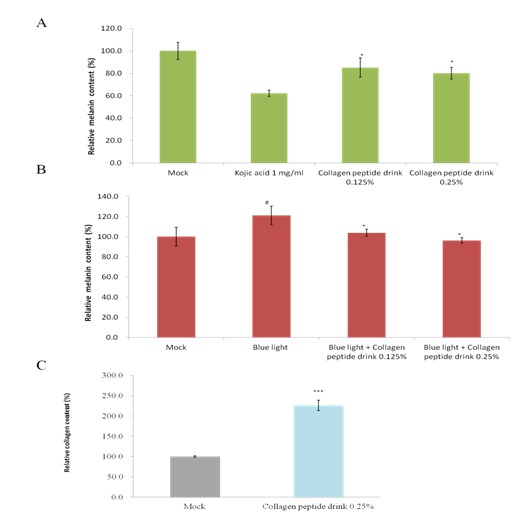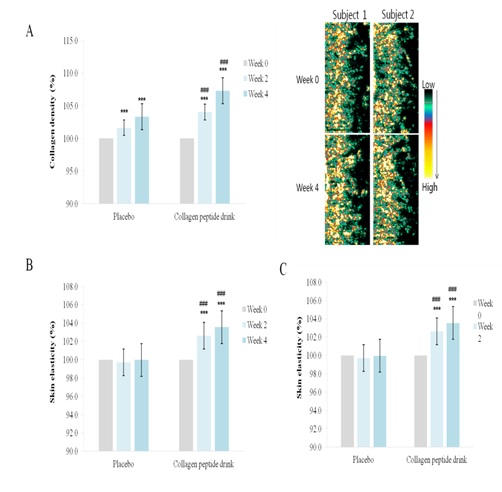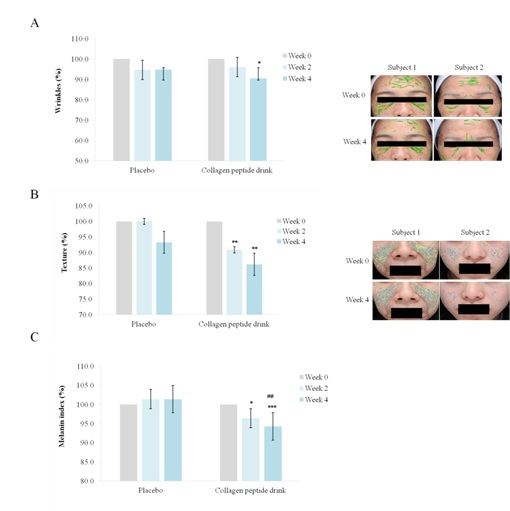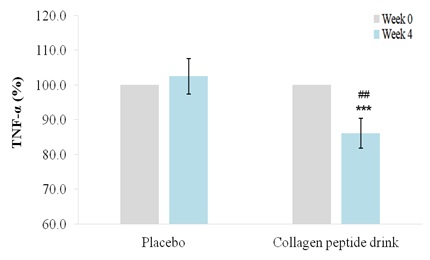
Collagen Peptide Combined with Annona Muricata Fermentation, Snow Lotus and Rosa Rugosa Improve Skin Condition and Anti-Inflammation
*Corresponding Author(s):
Chi-Fu ChiangResearch & Design Center, TCI CO., Ltd., Taipei, Taiwan
Tel:+886 287977811,
Email:Jimmy.Chiang@tci-bio.com
Abstract
Skin aging is a complex and continuous process that affects skin functions and appearance. In recent years, many plant-derived raw materials had also been used in functional foods or dietary supplements as one of the new and effective anti-aging skin care ingredients. This study explored whether collagen peptides combined with annona muricata fermentation, snow lotus and Rosa rugosa can improve skin condition. B16F10 cells and skin fibroblasts were treated with collagen peptide drink to examine melanin and collagen content. In the clinical trial, 60 subjects were recruited, divided into a placebo group and a collagen peptide drink group, and skin and inflammatory factors were analyzed after drinking for 4 weeks. In vitro results, collagen peptide drink inhibited melanin production and increased collagen in a dose dependent manner. In clinical, collagen peptide drink increased collagen, elasticity and hydration, and decrease decreased wrinkles, texture and melanin. These results suggested collagen drink with this formula had the potential to improve skin aging.
Keywords
Anti-inflammation; Annona muricata fermentation; Rosa rugosa; Snow lotus
Introduction
Skin aging was the most obvious external manifestation of human aging. In addition to age, it was actually related to heredity, ultraviolet radiation, diet, and lifestyle habits. During the aging process, the skin became thinner and the water content of the stratum corneum gradually decreased [1]. Therefore, the skin was more prone to dryness, and the collagen content and elasticity were decreases, and then wrinkles or sagging skin were formed. Collagen was an important protein in the connective tissues of the human body and was the most abundant protein in the human body [2]. Therefore, supplementing collagen can provide support for skin and tissues to maintain elasticity and moisture retention, thereby slowing and preventing skin aging. Hydrolyzed collagen was natural biologically active ingredients used in many beauty and health products [3]. Hydrolyzed collagen also called collagen peptide, which was composed of small peptides with a low molecular weight of 3-6 KDa, rich in amino acids, such as glycine and proline [4]. It was easier to be absorbed by the human body. Studies had shown that fish collagen peptide increased the Hyaluronic Acid (HA) production, and had better antioxidant capacity, photo-protection, immune regulation properties, and improved skin aging [5].
In recent years, many plant-derived raw materials had also been used in functional foods or dietary supplements as one of the new and effective anti-aging skin care ingredients [6]. Annona muricata (A. muricata) was an evergreen tree with a height of about 5-6m, which was popular in tropical regions of South and North America [7]. The sweet oval fruit was prickly, with white flesh inside the dark green or yellow-green peel. A. muricata was rich in phytochemicals such as polyphenols, alkaloids, terpenoids, polysaccharides, lactones, flavonoids, carotenoids and glycosides, and had excellent antioxidant and anti-inflammatory effects [8]. The studies showed that A. muricata extracts decrease melanogenesis in B16F10 mouse melanoma cells suggested skin-whitening effects, and these changes were reflected by decreased tyrosinase activities [9]. A. muricata was rich in vitamin C, which can effectively delay skin aging and whiten skin [10].
Saussurea involucrata (S. involucrate) was an endangered species in the Compositae family, which grown on the high mountains of Central Asia. S. involucrata was also called "snow lotus" in Chinese [11]. Snow lotus was a plant found high up in the Himalayas and had been used for centuries in beauty and wellness routines amongst many eastern cultures and traditional Chinese medicine [12]. Snow lotus inhibited the production of free radicals, which cause damage to other cells and cause many diseases [13]. Snow lotus inhibited lipid peroxidation of the cell membranes, which had anti-inflammatory properties, and decreased skin wrinkles and provided intense moisturization [14]. In addition, Rosa rugosa had been used as a medicinal plant in its native North-Eastern Asia for ages. The excellent anti-inflammatory properties of Rosa rugosa made it a valuable ingredient for the cosmetic industry [15]. Rosa rugosa was rich in phenols, phenolic acids, flavonoids, tannins and carotenoids [15]. The study had showed that it had antioxidant and antibacterial properties, and protected the skin from photoaging and environmental pollution. However, the clinical effects of annona muricata, snow lotus and Rosa rugosa on skin anti-aging were still unclear.
In this study, we additionally added annona muricata, snow lotus and Rosa rugosa to the collagen peptide drink to explore the anti-aging effect. Here, we used collagen peptide drink combined annona muricata with snow lotus and Rosa rugosa to examine whether can improve skin condition. First, we used collagen peptide drink to treat B16F10 cells and human skin fibroblast. Second we recruited 60 subjects, and assign to placebo group and collagen peptide drink group, then subjects took skin analysis after drinking for 4 weeks.
Materials And Methods
Cell culture
Melanoma cell line B16/F10 was obtained from American Type Culture Collection (ATCC), and cultured in Dulbecco’s modified Eagle’s medium (DMEM; Gibco, Carlsbad, CA, USA) supplemented with 10% fetal bovine serum (FBS; Gibco), 2mM of l-glutamine (Gibco), 100U/mL of penicillin and 100µg/mL of streptomycin (Nacalai Tesque, Kyoto, Japan). The human skin fibroblast was purchased from the ATCC, and cultured in dermal cell basal media supplemented with 0.4% Bovine Pituitary Extract (BPE), 0.1% recombinant human (rh) TGF-α (0.5ng/mL), 3% l-glutamine (6mM), 0.1% hydrocortisone hemisuccinate (100ng/mL), 0.1% rh insulin (5mg/mL), 0.1% epinephrine (1.0mM), 0.1% apotransferrin (5mg/mL; ATCC PCS-200-400), and 0.1% penicillin (100U/ml)-streptomycin (100µg/ml; Thermo Fisher Scientific), in a humidified incubator of 5% CO2 at 37°C.
Detection of melanin production
Seeding B16F10 melanoma cell (1.5x105 cells/well), and the collagen peptide drink to treat in a dose depend manner with blue light for 3 hours. After 24 hours of reaction, the melanin in the cells was dissolved with 1N NaOH (60°C-heat), and then the melanin content was quantified by measuring the wavelength of 405nm.
Collagen assay
Seeding human skin fibroblast (2×104 cells/well) on 24 well plate and incubate at 37°C for 24 hours. Then, collagen peptide drink was treated cells, and incubate for another 48 hr. Quantify the amount of collagen was performed according to the manufacturer’s protocol of a sircol collagen assay kit (Biocolor Ltd.,Northern Ireland, UK).
Clinical trial design
The study was registered in clinicaltrials.gov (No. NCT04996043), was performed under a protocol approved by the Antai Medical Care Cooperation Antai- Tian-Sheng memorial Hospital Institutional Review Board (Approval Number: 21-042-B). Written informed consent was obtained from all participants after a full explanation of study. A double-blinded, placebo controlled, randomized study was conducted. The subjects were randomly assigned to two groups with 30 subjects in each group. The subjects were informed to consume one bottle of drink every day for 4 weeks. The skin conditions of the subjects were measured on week 0, 2, 4 of the trial. Inclusion criteria: Healthy adults aged above 20-65 years old. The exclusion criteria included: i) skin disease, liver cirrhosis or chronic renal failure; ii) allergy to cosmetics, drugs, or foods; iii) pregnant and breastfeeding; iv) taking chronic drugs; v) people who had any cosmetic procedures (intense pulse light, medical peelings, or laser therapy) before 4 weeks of the study.
Test sample
The PEARLOSOPHY -collagen peptide drink contains: 12% annona muricata fermentation, 10% fish collagen peptide, 0.04% snow lotus and 0.01% Rosa rugosa, citric acid and water. Placebo drink of the main ingredient: citric acid and water.
Clinical skin efficacy assessment
DermaLab® Series SkinLab Combo was utilized to scan and analyze skin collagen density. The color scale indicates the density of collagen; white reflects the highest collagen density, and black reflects the lowest collagen density. Cutometer® dual MPA580 was utilized to measure skin elasticity, and the higher the relative value, the greater the improvement. VISIA™ Complexion Analysis was utilized to measure skin wrinkles and texture. Corneometer® CM825 was utilized to measure skin hydroation content, and the higher the relative value, the greater the improvement. Chroma Meter Mexameter® MX18 was utilized to measure skin melanin index, and the lower the relative value, the greater the improvement.
Inflammatory factor detection
The measurement of TNF-α in blood was based on the Enzymelinked immunosorbent assay (ELISA). The ELISA kits were obtained from Cloud-Clone Corp. (US). All experimental procedures were following the recommended protocols provided by the company.
Statistical analysis
The comparison of measurement results for skin parameters among groups and between groups was analyzed by one-way repeated measurement ANOVA and one-way ANOVA, respectively, followed by Tukey's post hoc test through GraphPad Prism, as p < .05 was considered statistical significance.
Results
Collagen peptide drink decreased melanin and increased collagen in vitro
To explore the effect of collagen peptide drink on melanogenesis, collagen peptide drink was used to treat B16F10 cells and examined melanin formation, we used kojic acid to inhibit to melanin formation, as negative control. We found collagen peptide drink decreased melanin formation in a dose dependent manner. 0.125% collagen peptide drink decreased melanin by 15%, and 0.25% collagen peptide drink decreased melanin by 20% compared to mock group (Figure 1A). In addition, we used blue light to induce melanin, and 0.125% collagen peptide drink decreased melanin by 17%, and 0.25% collagen peptide drink decreased melanin by 24.7% compared to blue light group (Figure 1B). Moreover, we found that 0.125% collagen peptide drink increased collagen content by 155.8% compared to mock group (Figure 1C). These results showed that collagen peptide drink can inhibit melanin production and increase collagen.

Figure 1: The collagen peptide drink decreased the melanin and collagen. (A) 0.125%, 0.25% collagen peptide drink to treat B16F10 cells, and melanin was quantified by absorbance analysis. Kojic acid to inhibit to melanin formation, as negative control. (n=3; mean±S.D.). *, p < 0.05 compared with mock. (B) 0.125%, 0.25% collagen peptide drink to treat B16F10 cells with blue light, and melanin was quantified by absorbance analysis. (n=3; mean±S.D.).#, p < 0.05 compared with mock. *, p < 0.05 compared with blue light. (C) 0.25% collagen peptide drink to treat human skin fibroblast, and collagen was measured by collagen assay kit. (n=3; mean±S.D.). ***, p < 0.001 compared with mock.
Collagen peptide drink increased collagen, elasticity and hydration
Next, we recruited 60 subjects, and assign to placebo group (n=30) and collagen peptide drink group (n=30), then subjects took skin analysis after drinking for 4 weeks. Collagen peptide drink increased skin collagen by 4%, 7.3% in week 2 and 4, respectively, compared to week 0 (before use), and increased by 2.4%, 4% in week 2 and 4, respectively, compared to placebo group (Figure 2A). Also, we found that Collagen peptide drink increased skin elasticity by 2.6%, 3.5% in week 2 and 4, respectively, compared to week 0 (before use), and increased by 2.9%, 3.5% in week 2 and 4, respectively, compared to placebo group (Figure 2B). In addition, Collagen peptide drink increased hydration by 1.9%, 4.6% in week 2 and 4, respectively, compared to week 0 (before use), and increased by 1.2%, 3.8% in week 2 and 4, respectively, compared to placebo group (Figure 2C). These results showed that collagen peptide drink can improve collagen, elasticity and hydration.
 Figure 2: Collagen peptide drink increased collagen, elasticity and hydration. The (A) density of collagen, (B) elasticity, (C) hydration, (n=30; mean value±S.E.M.) (***, compared with before using (week 0). ###, compared with placebo).
Figure 2: Collagen peptide drink increased collagen, elasticity and hydration. The (A) density of collagen, (B) elasticity, (C) hydration, (n=30; mean value±S.E.M.) (***, compared with before using (week 0). ###, compared with placebo).
Collagen peptide drink decreased wrinkles, texture and melanin.
Further, Collagen peptide drink decreased skin wrinkles by 3.9%, 9.4% in week 2 and 4, respectively, compared to week 0 (before use) (Figure 3A), and decreased texture by 9.1%, 13.8% in week 2 and 4, respectively, compared to week 0 (before use) (Figure 3B). Finally, we also found that collagen peptide drink decreased skin melanin by 3.6%, 5.7% in week 2 and 4, respectively, compared to week 0 (before use) (Figure 3C). These results showed that collagen peptide drink can improve wrinkles, texture and melanin.
 Figure 3: Collagen peptide drink decreased wrinkles, texture and melanin. The (A) wrinkles, (B) texture, (C) melanin, (n=30; mean value±S.E.M.) (*, compared with before using (week 0). #, compared with placebo) (*, p < 0.05, **, p < 0.01, ***, p < 0.001) ( ## , p < 0.01).
Figure 3: Collagen peptide drink decreased wrinkles, texture and melanin. The (A) wrinkles, (B) texture, (C) melanin, (n=30; mean value±S.E.M.) (*, compared with before using (week 0). #, compared with placebo) (*, p < 0.05, **, p < 0.01, ***, p < 0.001) ( ## , p < 0.01).
Collagen peptide drink decreased inflammation.
Finally, we analyzed the inflammatory factors in the blood of the subjects, we found that collagen peptide drink decreased TNF-α by 16.3% in week 4 compared to week 0 (before use), and decreased by 13.8% in week 4 compared to placebo group (Figure 4). These results showed that collagen peptide drink decreased inflammation.
 Figure 4: Collagen peptide drink decreased inflammation. The subjects were examined TNF-α in blood after drinking for 4 weeks. (*, compared with before using (week 0). #, compared with placebo) (***, p < 0.001) ( ## , p < 0.01).
Figure 4: Collagen peptide drink decreased inflammation. The subjects were examined TNF-α in blood after drinking for 4 weeks. (*, compared with before using (week 0). #, compared with placebo) (***, p < 0.001) ( ## , p < 0.01).
Discussion
This study found that collagen drink containing annona muricata, snow lotus and Rosa rugosa can increase collagen production, elasticity and hydration, and decrease decreased wrinkles, texture and melanin, suggesting the collagen drink with this formula had the potential to improve skin aging. Studies showed that A. muricata extract can reduce melanin content in B16F10 cells, and it was also found that the A. muricata decreased tyrosinase mRNA and protein expression9. Tyrosinase was mainly through the expression of Tyrosinase-Related Protein 1 (TRP-1) and TRP-2 transcription factors, and A. muricata can inhibit TRP-1 and TRP-2, indicating that A. muricata as a skin whitening ingredient in functional cosmetics [16]. Studies had showed that there were many phenolic compounds in A. muricata, including quercetin and gallic acid. The biologically active properties of quercetin include anti-oxidant and anti-aging effects [17]. Quercetin can reduce UV-mediated skin aging, and can also inhibit the Matrix Metalloproteinase-1 (MMP-1) and Cyclooxygenase-2 (COX-2) expression, and prevent collagen degradation through inhibiting Janus Kinase 2 (JAK2) kinase activity [18]. A. muricata had a high vitamin C content, which can help eliminate free radicals, had anti-oxidation, enhances immunity, anti-inflammatory, and can also inhibit the formation of wrinkles [19].
In recent years it had been showed that Chinese herbal medicine can enhance skin elasticity, reduce skin keratinization, pigmentation and prevent loss of sebum function [20]. Snow lotus extract had the ability to scavenge free radicals, as an antioxidant, and enhanced collagen production and fibroblast growth [21]. In addition, snow lotus was rich in fucose mucilage and various phenolic compounds, and was often used as a natural moisturizer, anti-inflammation and wound repair ingredients [11]. Snow lotus extract contained flavonid, polysaccharide, which can effectively protect the skin from ultraviolet rays, and had a significant inhibitory effect on the increase of lipid peroxides in the liver and serum caused by toxins in the body. Rutin was one of the main components in Tianshan snow lotus extract [22], and it can reduce the Cyclooxygenase II (COX-2) expression by inhibiting NF-κB [23], and reduce the apoptosis, and had anti-aging effects.
The polysaccharides extracted from Rosa rugosa were developed into natural moisturizing ingredients and cosmetic raw materials [24]. Studies had shown that rose essential oil, crude anthocyanins and crude polysaccharides had high antioxidant capacity. Rose essential oil can inhibit the ability of tyrosinase and had skin whitening effect [25]. Rosa rugosa was suitable for all skin types, but it was especially suitable for dry skin as it had extremely moisturizing properties that can help relieve itching and protect the skin from moisture loss [26]. Rosa rugosa contained vitamins A and C, which helped the skin anti-aging, reduced wrinkles and spots in the skin, and promoted collagen production [27]. The fatty acids in Rosa rugosa oil were beneficial for decreasing skin inflammations, including eczema [28]. Rosa rugosa also regulated hydration, which controlled excess oil production and helped the skin maintain its natural pH balance [29]. Consistent with our results, collagen drink containing annona muricata, snow lotus and Rosa rugosa can increase collagen production, elasticity and hydration, and decrease decreased wrinkles, texture and melanin. Therefore, these herbal extracts had promising skin benefits and had potential for use as active ingredients in cosmetic/cosmeceutical products.
Conclusion
This study was first demonstrated the combined fish collagen with annona muricata, snow lotus and Rosa rugosa for the substantial improvements in collagen, spots, melanin, wrinkles, texture and pores in the skin. Therefore, fish collagen, annona muricata, snow lotus and Rosa rugosa can be used as novel sources of anti-aging ingredients for skincare in the future.
Conflict of Interest
The authors declare no conflict of interest
References
- Albuquerque PBS, de Oliveira WF, Dos Santos Silva PM, Dos Santos Correia MT, Kennedy JF, et al. (2022) Skincare application of medicinal plant polysaccharides - A review. Carbohydr Polym 277: 118824.
- Xiao Z, Yang S, Liu Y, ZhouC, Hong P, et al. (2022) A novel glyceroglycolipid from brown algae Ishige okamurae improve photoaging and counteract inflammation in UVB-induced HaCaT cells. Chem Biol Interact 351: 109737.
- Lupu MA, Pircalabioru GG, Chifiriuc MC, Albulescu R, Tanase C (2020) Beneficial effects of food supplements based on hydrolyzed collagen for skin care (Review). Exp Ther Med 20: 12-17.
- Leon-Lopez A, Morales-Penaloza A, Martinez-Juarez VM, Vargas-Torres A, Zeugolis DI, et al. (2019) Hydrolyzed collagen-sources and applications. Molecules 24: 4031.
- Song H, Zhang S, Zhang L, Li B (2017) Effect of orally administered collagen peptides from bovine bone on skin aging in chronologically aged mice. Nutrients 9: 1209.
- Lourenco SC, Moldao-Martins M, Alves VD (2019) Antioxidants of natural plant origins: From sources to food industry applications. Molecules 24: 4132.
- Zorofchian S, Fadaeinasab M, Nikzad S, Mohan G, Ali H, et al. (2015) Annona muricata (Annonaceae): A review of its traditional uses, isolated acetogenins and biological activities. Int J Mol Sci 16: 15625-15658.
- Wahab SMA, Jantan I, Haque MA, Arshad L (2018) Exploring the leaves of Annona muricata L. as a Source of potential anti-inflammatory and anticancer agents. Front Pharmacol 9: 661.
- Joo D, Jeong S, Lee HK, Shin SH, Choi SJ, et al. (2017) Annona muricata L. extracts decrease melanogenesis in B16F10 mouse melanoma cells. Biomedical Dermatology 1: 10.
- Schagen SK, Zampeli VA, Makrantonaki E, Zouboulis CC (2012) Discovering the link between nutrition and skin aging. Dermatoendocrinol 4: 298-307.
- Chik WI, Zhu L, Fan LL, Yi T, Zhu GY, et al. (2015) Saussurea involucrata: A review of the botany, phytochemistry and ethnopharmacology of a rare traditional herbal medicine. J Ethnopharmacol 172: 44-60.
- Gong G, Huang J, Yang Y, Qi B, Han G, et al. (2019) Saussureae involucratae herba (Snow Lotus): Review of chemical compositions and pharmacological properties. Front Pharmacol 10: 1549.
- Lobo V, Patil A, Phatak A, Chandra N (2010) Free radicals, antioxidants and functional foods: Impact on human health. Pharmacogn Rev 4: 118-126.
- Silva S, Michniak-Kohn B, Leonardi GR (2017) An overview about oxidation in clinical practice of skin aging. An Bras Dermatol 92: 367-374.
- Tursun X, Zhao Y, Talat Z, Xin X, Tursun A, et al. (2016) Anti-inflammatory effect of Rosa rugosa flower extract in lipopolysaccharide-stimulated RAW264.7 macrophages. Biomol Ther (Seoul) 24: 184-190.
- Kwon KJ, Bae S, Kim K, An IS, Ahn KJ, et al. (2014) Asiaticoside, a component of Centella asiatica, inhibits melanogenesis in B16F10 mouse melanoma. Mol Med Rep 10: 503-507.
- Aryal S, Baniya MK, Danekhu K, Kunwar P, Gurung R, et al. (2019) Total phenolic content, flavonoid content and antioxidant potential of wild vegetables from western Nepal. Plants (Basel) 8: 96.
- Shin EJ, Lee JS, Hong S, Lim TG, Byun S (2019) Quercetin directly targets JAK2 and PKCδ and prevents UV-induced photoaging in human skin. Int J Mol Sci 20: 5262.
- Tran NYT, Nhan NPT, Thanh VT, Chinh ND, Tri DL, et al. (2020) Effect of storage condition on color, vitamin C content, polyphenol content and antioxidant activity in fresh soursop pulp (Annona muricata L.). IOP Conference Series: Materials Science and Engineering 736: 022065.
- Liu T, Li N, Yan YQ, Liu Y, Xiong K, et al. (2020) Recent advances in the anti-aging effects of phytoestrogens on collagen, water content, and oxidative stress. Phytother Res 34: 435-447.
- Xu M, Guo Q, Wang S, Wang N, Wei L, et al. (2016) Anti-rheumatoid arthritic effects of Saussurea involucrata on type II collagen-induced arthritis in rats. Food Funct 7: 763-770.
- Gong G, Zheng Y (2021) The anti-UV properties of Saussurea involucrate Matsum. & Koidz. Via regulating PI3K/Akt pathway in B16F10 cells. J Ethnopharmacol 269: 113694.
- Yang YC, Lin HY, Su KY, Chen CH, Yu YL, et al. (2012) Rutin, a flavonoid that is a main component of saussurea involucrata, attenuates the senescence effect in D-galactose aging mouse model. Evid Based Complement Alternat Med 2012: 980276.
- Olech M, Nowacka-Jechalke N, Maslyk M, et al. (2019) Polysaccharide-rich fractions from Rosa rugosa-composition and chemopreventive potential. Molecules 24: 1354.
- Solimine J, Garo E, Wedler J, Rusanov K, Fertig O, et al. (2016) Tyrosinase inhibitory constituents from a polyphenol enriched fraction of rose oil distillation wastewater. Fitoterapia 108: 13-19.
- Zhang C, Zhao F, Li R, Wu Y, Liu S, et al. (2018) Purification, characterization, antioxidant and moisture-preserving activities of polysaccharides from Rosa rugosa International Journal of Biological Macromolecules 124: 938-945.
- Al-Yafeai A, Bellstedt P, Bohm V (2018) Bioactive compounds and antioxidant capacity of Rosa rugosa depending on degree of ripeness. Antioxidants (Basel) 7: 134.
- Marmol I, Sanchez-de-Diego C, Jimenez-Moreno N, Ancin-Azpilicueta C, Rodriguez-Yoldi MJ (2017) Therapeutic applications of rose hips from different Rosa species. Int J Mol Sci 18: 1137.
- Zawi?lak A, Michalczyk M (2015) Antioxidant properties of low-processed wrinkled rose (Rosa rugosa) petals. Food Science Technology Quality 22.
Citation: Lin YK, Lin YH, Chan ST, Yuting S, Chiang CF (2022) Collagen Peptide Combined with Annona Muricata Fermentation, Snow Lotus and Rosa Rugosa Improve Skin Condition and Anti-Inflammation. J Food Sci Nutr 8: 126.
Copyright: © 2022 Yung-Kai Lin, et al. This is an open-access article distributed under the terms of the Creative Commons Attribution License, which permits unrestricted use, distribution, and reproduction in any medium, provided the original author and source are credited.

